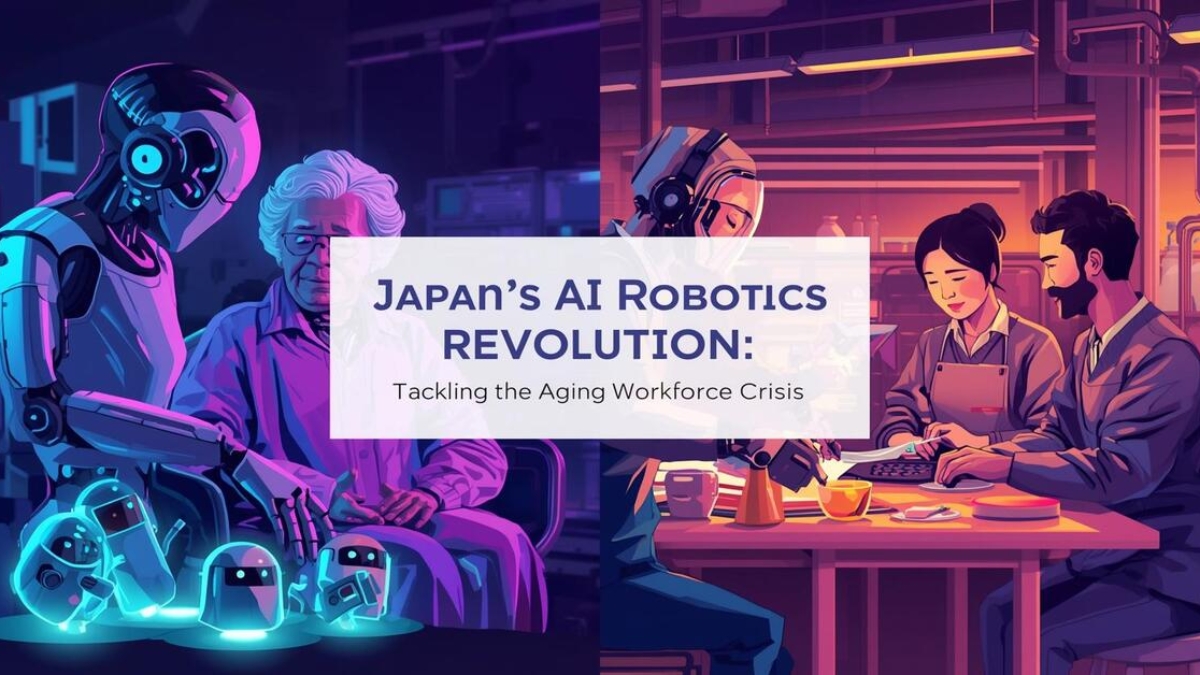Table of Contents
Japan’s AI Robotics Revolution: Tackling the Aging Workforce Crisis
Imagine a country where the wisdom of elders is celebrated, yet their growing numbers create a labor crisis. This is Japan today: a “super-aging society” with shrinking birth rates and a projected 11 million worker shortfall by 2040. Instead of giving in, Japan is turning to AI and robotics to sustain healthcare, industry, and daily life.
Key Takeaways
- Japan’s aging population is fueling an urgent labor shortage across healthcare, manufacturing, and services.
- AI-driven robots like AIREC assist with elder care tasks, while PARO and Pepper provide emotional support.
- Beyond care homes, industrial robots and cobots keep factories and logistics running, while robot avatars open new work opportunities.
- The government supports innovation through policies like Society 5.0, blending tech and human-centered solutions.
- Challenges include high costs, safety, and cultural acceptance, but Japan envisions a future of human-robot collaboration.
Why Robotics Is Critical for Japan
By 2030, one in four Japanese citizens will be over 65. Caregiver shortages are severe—4.25 job openings for every applicant in nursing. This strain extends to logistics, retail, and manufacturing. For Japan, robotics isn’t optional—it’s survival.
AI in Elder Care: Beyond Human Limits
- Physical Support (AIREC): Waseda University’s humanoid robot lifts, repositions, and assists elderly patients, reducing caregiver strain.
- Emotional Care (PARO & Pepper): PARO, a robotic seal, reduces loneliness; Pepper leads light exercises and conversations.
- Monitoring & Early Detection: Sensors track sleep patterns, while AI analyzes speech for early dementia signs.
Beyond Care Homes: Industry & Services
- Manufacturing: Japan leads in industrial robotics, with cobots working beside humans on repetitive or dangerous tasks.
- Logistics & Retail: From automated warehouses to self-checkouts, robots keep services running despite labor gaps.
- The DAWN Café: Robot waiters remotely controlled by disabled workers show how tech fosters inclusive work models.
Government’s Role: Society 5.0
Japan’s Society 5.0 initiative blends cyberspace and real-world problem-solving. With heavy R&D funding, policy reforms, and caregiver tech adoption, Japan ensures robots enhance—not replace—human work.
Challenges Ahead
- High Costs: Advanced robots like AIREC cost around $67,000.
- Safety & Reliability: Machines must safely interact with vulnerable people.
- Cultural Resistance: Many still value the warmth of human touch over robotic care.
- Lessons Learned: Failed robots like Robear prove practical design matters as much as innovation.
The Future: Human-Robot Symbiosis
By 2040, robots will assist most caregivers; by 2050, they may evolve into empathetic companions. The vision isn’t replacement, but partnership—robots handling the physical and repetitive, humans focusing on empathy, creativity, and complex decisions.
FAQs (Quick Answers)
1. How is Japan using AI robotics to support its aging workforce?
Japan deploys AI-powered robots in elder care, manufacturing, logistics, and service sectors. Robots like AIREC assist with physically demanding tasks, while companion robots like PARO and Pepper provide emotional support. Industrial cobots help maintain productivity in factories and warehouses, addressing labor shortages.
2. What are some AI care robots used in Japan?
- AIREC: Humanoid robot for lifting, repositioning, and assisting elderly patients.
- PARO: Therapeutic robotic seal for emotional support and mental stimulation.
- Pepper: Interactive robot for conversation, exercises, and engagement in care facilities.
3. Why does Japan need robotics for elder care?
With a super-aging society, one in four citizens will be over 65 by 2030. Labor shortages in healthcare are severe, with far fewer caregivers than needed. Robotics help fill gaps, reduce caregiver strain, and improve elderly quality of life.
4. How is AI robotics used beyond elder care in Japan?
Robotics and AI automation are also applied in:
- Manufacturing: Cobots working alongside humans to perform repetitive or hazardous tasks.
- Logistics & retail: Automated warehouses, self-checkouts, and touch-screen ordering systems.
- Innovative work models: Robot avatars in cafés enable remote work for people with disabilities.
5. What role does the Japanese government play in AI robotics adoption?
The government funds research, creates national centers for care robot development, revises policies for tech adoption, and promotes initiatives like Society 5.0, ensuring AI and robotics enhance human-centered solutions rather than replace human workers.
6. Are AI robots replacing human caregivers in Japan?
No. Robots are designed to assist and complement humans, taking over physically demanding, repetitive, or monitoring tasks. Human caregivers still provide empathy, judgment, and complex decision-making.
7. What challenges does Japan face in implementing AI robotics?
- High costs (e.g., AIREC costs ~$67,000)
- Safety and technological maturity
- Cultural preference for human touch and interaction
- Need for practical, user-centered designs
8. What is the future vision of AI robotics in Japan?
Japan envisions human-robot symbiosis, where robots handle repetitive, dangerous, or physically demanding tasks, freeing humans to focus on empathy, creativity, and complex problem-solving. This model could serve as a blueprint for other aging nations worldwide.
Final Glimpse
Japan’s embrace of AI and robotics is more than innovation—it’s a survival strategy and a global blueprint. By merging tradition with technology, Japan is proving that even the toughest demographic challenges can be solved through human-robot collaboration.

